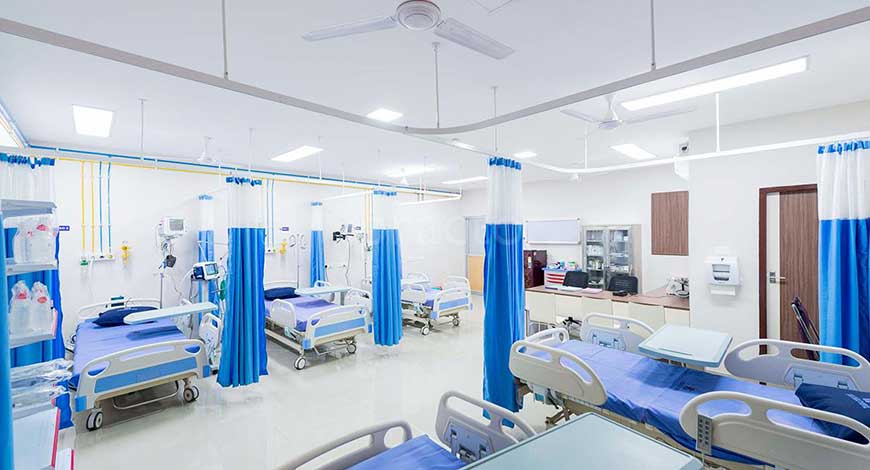International Circuit
Japan hospitals sluggish in adopting seismic isolation

A major earthquake that hit the Noto Peninsula on New Year’s Day damaged hospitals tasked with providing medical care in the region, limiting their ability to conduct surgeries or accept inpatients.
In hospitals in areas severely affected by the quake, testing equipment and pipes were destroyed and some have not been able to resume surgeries and other medical services.
Meanwhile, some hospitals were able to continue offering medical care, as damage to their buildings was minimized with seismic isolation — a construction method of uncoupling a structure from its foundation to prevent seismic tremors from being transmitted to the building.
Seismic isolation is an effective way to protect buildings, but the spread of the technology in the country has been slow as it is more costly compared with seismic reinforcement, a method to resist seismic forces by increasing the rigidity of buildings.
Beyond expectations
Wajima Municipal Hospital is located in Wajima, Ishikawa Prefecture, a city struck by the earthquake, which measured up to the maximum level of 7 on Japan’s seismic intensity scale.
As the strong quake shook the hospital, testing devices fell one after another and its MRI device used for diagnoses broke down.
While the hospital building itself did not suffer major damage, sewer pipes were damaged, forcing the hospital to transfer 100 inpatients to other facilities.
The hospital is designated a “disaster base” hospital, equipped to provide medical care to patients during natural disasters, and meets the quake-resistance standard.
“We had been preparing to be able to respond to quakes about the same level as the 2007 Noto Peninsula earthquake (that measured up to upper 6 in the seismic intensity scale), but the latest quake was beyond our expectations,” said Kuniyuki Kawasaki, 54, head of the hospital’s administration division.
Since immediately after the quake, doctors and nurses at the hospital have worked tirelessly to care for emergency patients and those with infectious diseases, but still cannot resume surgeries as they are yet to be able to replace all the damaged testing devices with new ones.
According to the health ministry’s survey released in October regarding anti-seismic reinforcement renovations made to hospital buildings, 79.5% of hospitals nationwide have been reinforced against earthquakes as of September 2022.
The government’s earthquake resistance standard requires buildings not to collapse even with earthquakes measuring upper 6 and 7. But even if buildings are reinforced to meet the standard, it doesn’t mean all of the vibrations caused by the ground shaking can be minimized.
Giving birth safely
On the other hand, a seismic isolation structure insulates a building from the ground by using multiple layers of rubber sheets and shock absorbers to prevent the transmission of seismic energy to the building as much as possible.
It helps minimize damage to hospital buildings and medical equipment installed inside.
Keiju Medical Center, the core hospital in Nanao, Ishikawa Prefecture, was rattled by an upper-6 tremor, and its labor and delivery room at the obstetrics ward became unusable due to water leakage.
An operating room of the hospital’s main building, which had been built in 2013 with seismic isolation, was used instead as a delivery room and a baby was born safely at 2 a.m. on Jan. 2, roughly 10 hours after the quake.
The two buildings other than the main building, which have not adopted seismic isolation, suffered severe damage, including the ceiling coming down and medical equipment being scattering around.
For safety, some 100 inpatients were moved to the main building, which had less damage.
“The main building was impregnable thanks to seismic isolation,” said Toru Kamata, 63, head of the hospital, recalling the days immediately after the quake. “We were able to continue offering medical care. I have nothing but gratitude for seismic isolation.”
Lack of subsidies
The health ministry survey shows that as of September 2022, only 7.9% of hospitals nationwide have adopted seismic isolation in their buildings. Even for disaster base hospitals and emergency and critical care centers alone, the proportion still remains as low as 21.4%.
None of the four disaster base hospitals in the Noto region, including Wajima Municipal Hospital, has seismically isolated structures.
An official from a disaster base hospital in the Chubu region that does not adopt seismic isolation said, “Because adopting seismic isolation involves the foundations of buildings, the issue doesn’t easily come up for discussion unless we are considering newly building or rebuilding structures.”
There are construction methods to make existing buildings seismically isolated, but according to the Japan Society of Seismic Isolation, they could cost more than twice as much as anti-seismic reinforcement work.
While the government provides subsidies for anti-seismic reinforcement work in order to increase the proportion of quake-resistant hospitals, it does not offer subsidies that specifically encourage seismic isolation.
Nobuo Fukuwa, professor emeritus at Nagoya University well-versed in earthquake disaster prevention, pointed out, “In hospitals that need to maintain medical care, it is desirable that they adopt seismic isolation rather than seismic reinforcement.”
“In the event of a major earthquake in the Nankai Trough (an ocean-floor trench that runs along the Pacific coast of southwest Japan) that could cause damage to a wide range of areas, (hospitals that suffer damage) cannot expect hospitals in other areas to accept their patients,” Fukuwa stressed. “It is necessary for authorities to provide assistance so that hospitals will quickly proceed with adopting seismic isolation.” The Japan Times












